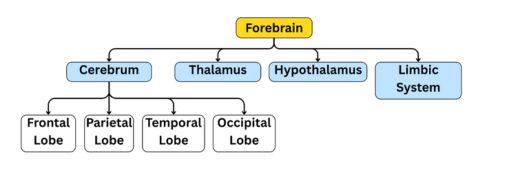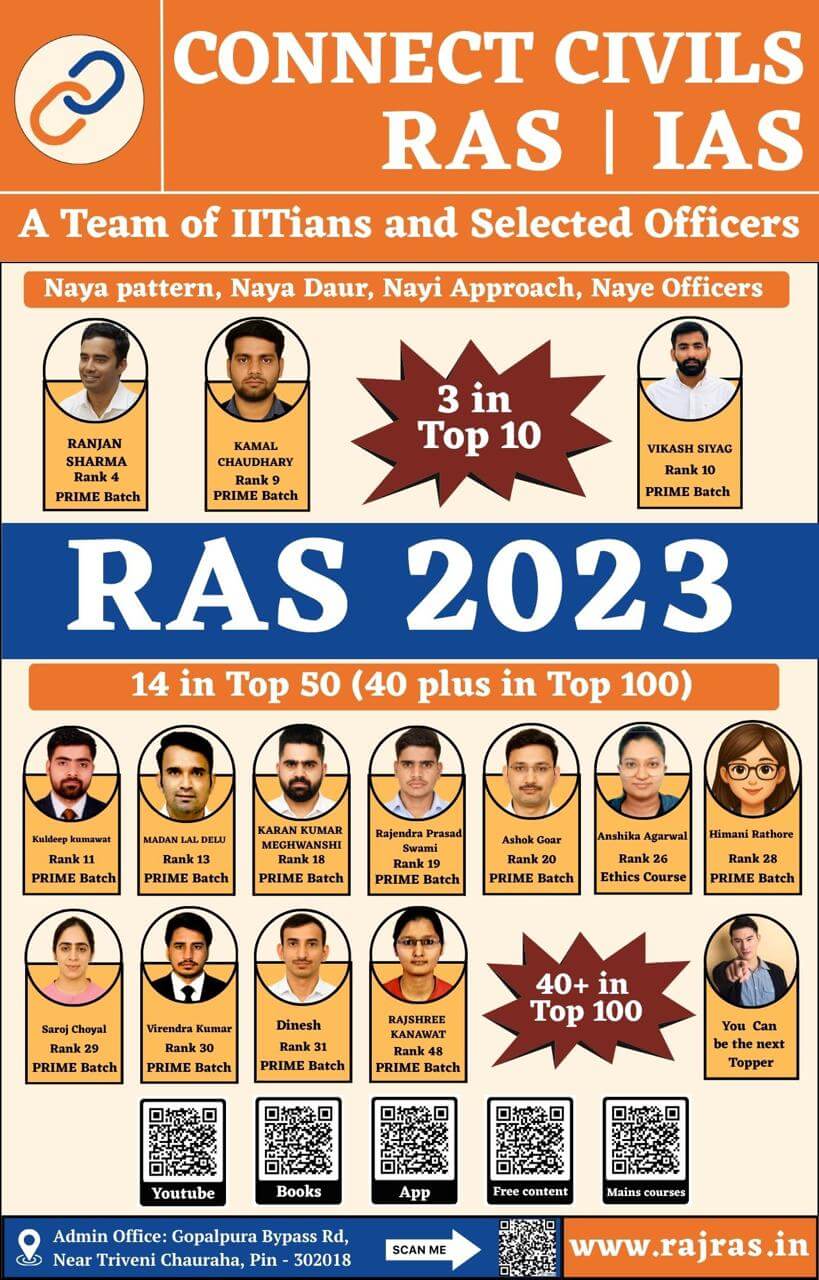Neural Control and Coordination in Biology refers to the process by which the nervous system and sense organs work together to regulate and coordinate various activities of the body. It ensures that the body responds quickly and efficiently to internal and external stimuli, maintaining proper communication between different organs and systems.
NEURAL CONTROL AND COORDINATION
Coordination is crucial for maintaining homeostasis—the stable and balanced internal environment necessary for proper functioning. In humans, the organs and organ systems need to work together in a synchronized manner to ensure the body operates efficiently. This coordination allows the body to respond to external and internal changes, ensuring processes such as metabolism, temperature regulation, and muscle activity happen smoothly.
- Two key systems responsible for coordination in the human body are the nervous system and the endocrine system.
- Nervous System:
- The nervous system provides rapid, point-to-point communication through electrical signals (nerve impulses) that travel along neurons. These impulses allow the body to respond quickly to stimuli.
- The nervous system is responsible for coordinating actions that require immediate and precise responses. For instance, when you touch a hot object, the nervous system allows you to pull your hand away quickly, preventing injury.
- Endocrine System:
- The endocrine system, on the other hand, provides slower but longer-lasting coordination through the release of hormones into the bloodstream. Hormones travel to various target organs, regulating processes like growth, metabolism, and reproduction.
- The endocrine system ensures that the body maintains balance over a longer period. For example, the release of insulin and glucagon regulates blood glucose levels, which ensures that cells have a steady supply of energy.
Neural System in Humans
The neural system in humans is a highly specialized network that coordinates the body’s activities, processes sensory information, and helps in communication between different parts of the body. The system is made up of cells called neurons, which are capable of detecting, receiving, and transmitting various types of stimuli. In humans, the neural system is divided into two main parts:
- Central Nervous System (CNS)
- Peripheral Nervous System (PNS)
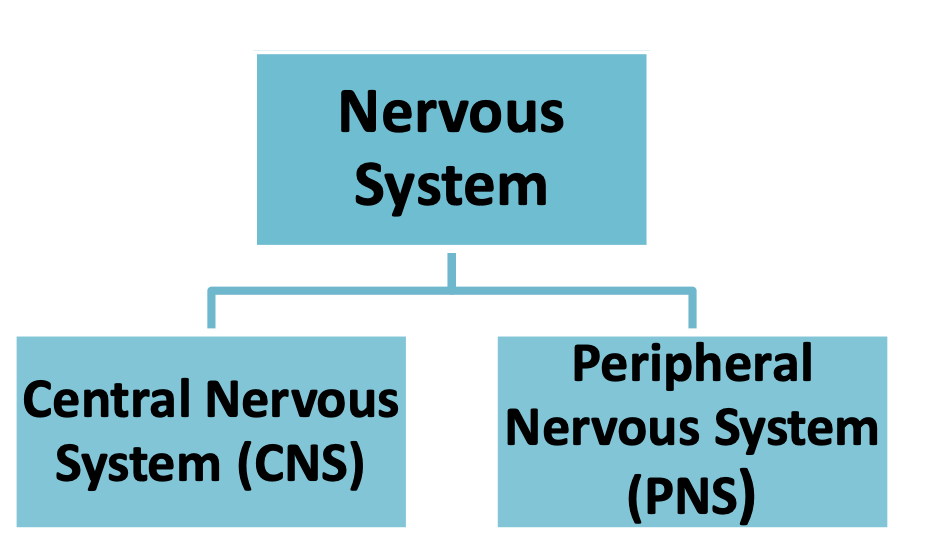
Central Nervous System (CNS)
- Components: Brain + Spinal Cord
- Function: Control center, processes sensory info, decision-making, cognition, memory, emotions.
Peripheral Nervous System (PNS)
- Components: Nerves outside CNS
- Functions: Connects CNS to body parts (organs, muscles, glands)
- Types of Fibers:
- Afferent Fibers: Carry sensory info to CNS
- Efferent Fibers: Carry motor commands from CNS to body
- PNS Divisions:
- Somatic Nervous System: Controls voluntary movements + sensory info from skeletal muscles
- Autonomic Nervous System: Controls involuntary functions (heart rate, digestion)
- Sympathetic: “Fight or flight” (increases heart rate, blood pressure)
- Parasympathetic: “Rest and digest” (slows heart rate, increases digestion)
- Visceral Nervous System: Controls impulses to/from internal organs.
Neurons
- Structural and Functional Units of the Neural System
- Neurons are the fundamental units of the nervous system, responsible for transmitting nerve impulses.
Each neuron consists of three primary components:
- Cell Body (Soma):
- The cell body houses the nucleus and other cell organelles. It also contains Nissl’s granules, which are involved in protein synthesis essential for the neuron’s function.
- Dendrites:
- Dendrites are short, branched fibers that project out of the cell body. These fibers receive signals from other neurons or sensory cells and transmit the impulses towards the cell body.
- Axon:
- The axon is a long, single fiber that transmits nerve impulses away from the cell body to other neurons, muscles, or glands. At the end of the axon, the fibers branch into synaptic knobs or terminals, which contain synaptic vesicles filled with neurotransmitters. These neurotransmitters help transmit the signal across the synapse (the gap between two neurons).
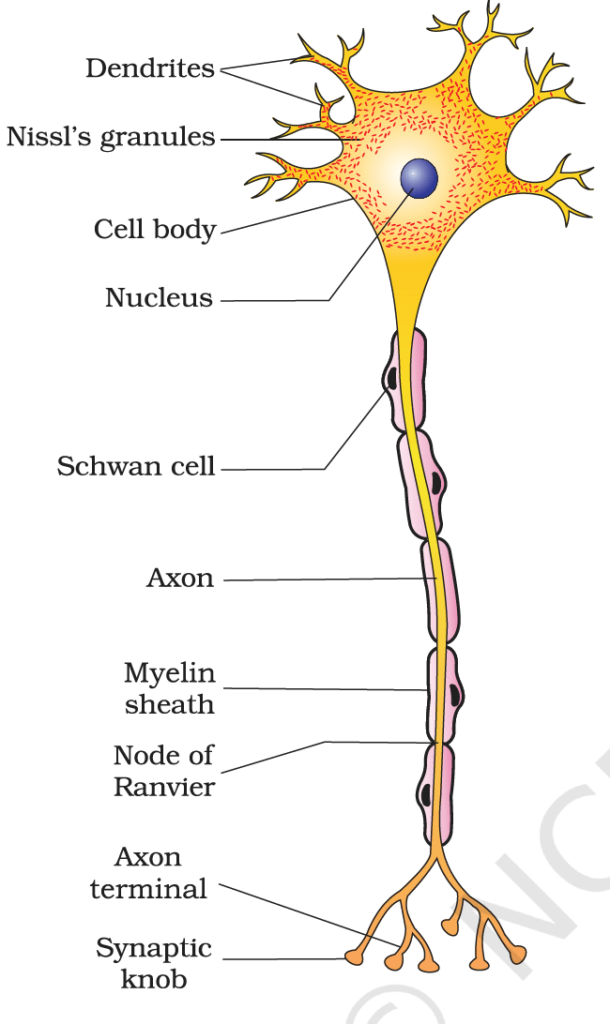
Fig: Structure of a neuron
Types of Neurons
Neurons are classified based on the number of axons and dendrites they have:
- Multipolar Neurons: 1 axon, multiple dendrites (most common, found in cerebral cortex).
- Bipolar Neurons: 1 axon, 1 dendrite (found in sensory organs, e.g., retina).
- Unipolar Neurons: Single process splits into two branches (found in embryos).
Transmission of Nerve Impulses
- Nerve Impulse Generation:
- A stimulus (e.g., touch, sound) triggers a change in electrical charge in a neuron.
- Movement of ions (sodium, potassium) generates an action potential (nerve impulse).
- Impulse Conduction:
- The action potential travels along the neuron’s axon toward the synapse.
- Synaptic Transmission:
- At the synapse, the electrical impulse triggers the release of neurotransmitters.
- Neurotransmitters cross the synaptic gap and bind to receptors on the next neuron.
- Impulse Propagation:
- Binding of neurotransmitters causes a change in the postsynaptic neuron’s membrane potential.
- This may generate a new action potential, continuing the signal transmission.
- Signal Reaches Target:
- The signal travels along the neural pathway to its target (e.g., muscles or glands).
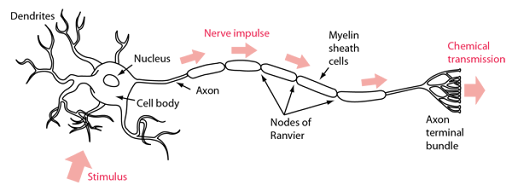
Central Neural System (CNS)
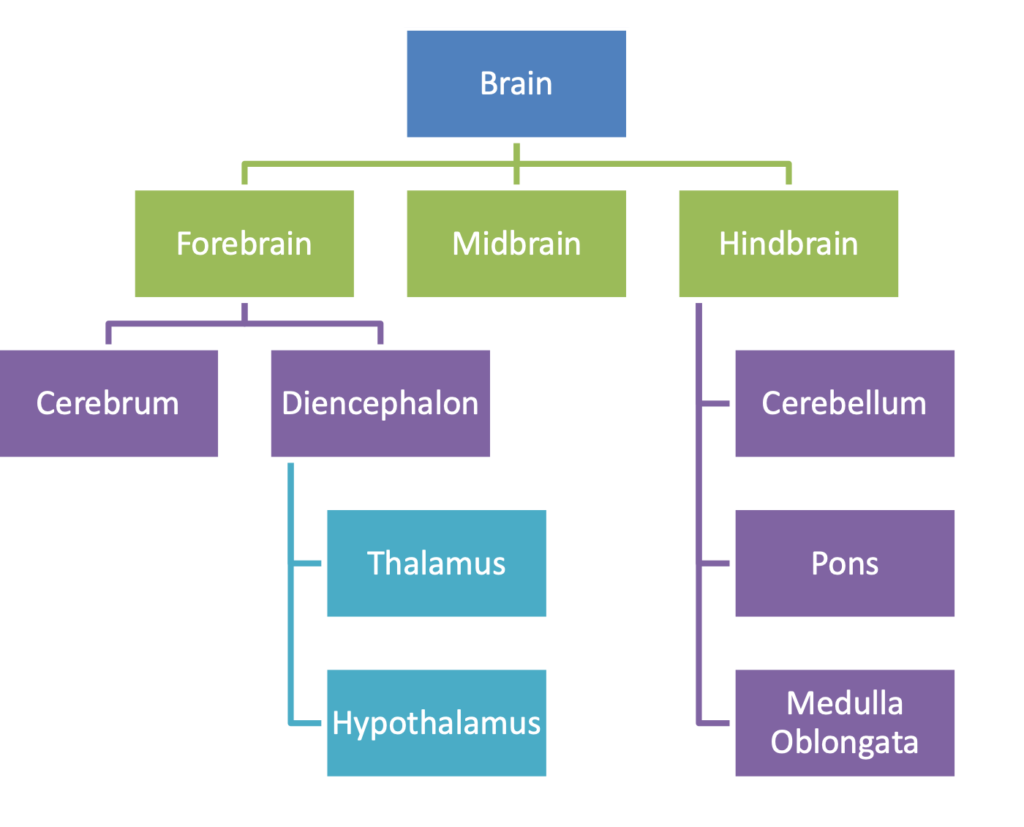
The Central Nervous System (CNS), comprising the brain and the spinal cord, is the primary control and coordination center of the body. It processes and integrates sensory information, generates thoughts, emotions, and memories, and initiates the response to stimuli. The brain, as the command center, regulates numerous critical functions that are vital for the survival and wellbeing of the body.
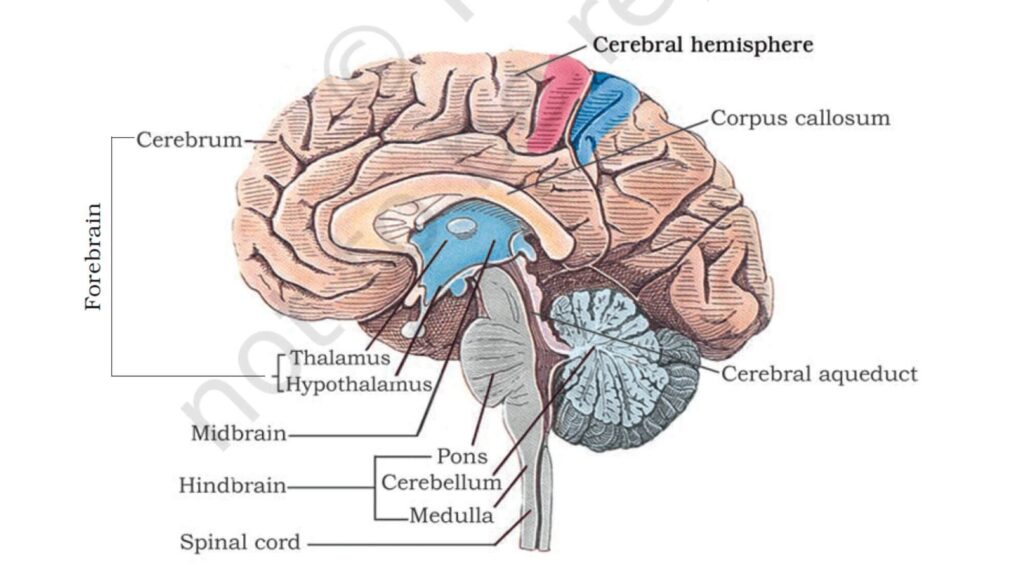
Brain
Functions of the Brain:
- Voluntary Movement Control:
- The brain controls voluntary muscle movements, allowing actions like walking, talking, and fine motor skills such as writing or playing an instrument.
- Regulation of Involuntary Organs:
- It also manages involuntary functions such as the beating of the heart, breathing, and digestion. These are controlled by different parts of the brain, particularly in the hindbrain and brainstem.
- Homeostasis:
- The brain plays a central role in maintaining homeostasis in the body by regulating key processes such as body temperature (thermoregulation), hunger, thirst, and circadian rhythms (24-hour biological cycles).
- Emotions and Behavior:
- Higher functions such as emotions, thought processes, intelligence, and memory are processed in specific areas of the brain. For example, the limbic system is crucial for emotions, and the cerebral cortex is involved in higher cognitive functions like reasoning and problem-solving.
- Endocrine System Regulation:
- The brain communicates with and regulates several endocrine glands, influencing hormone production and secretion. For instance, it controls the pituitary gland, which in turn regulates growth, metabolism, and reproduction.
- Sensory Processing:
- The brain is the site for processing sensory inputs such as vision, hearing, taste, touch, and smell. These sensory signals are interpreted to generate perceptions and responses.
Divisions of the Brain:
- Forebrain
- Cerebrum
- Divided into left & right hemispheres
- Connected by corpus callosum (for communication)
- Cerebral Cortex: Gray matter, folded to increase surface area; responsible for motor functions, sensory processing, memory, intelligence, communication
- White Matter: Nerve fibers coated with myelin for communication between brain regions
- Thalamus: Relay station for sensory & motor signals
- Hypothalamus: Regulates body temperature, hunger, thirst, and internal clock; influences hormones
- Limbic System: Includes amygdala (emotions) and hippocampus (memory), controls emotions, motivation, and behavior
- Cerebrum
- Midbrain
- Located between forebrain and hindbrain
- Processes visual, auditory, and sensory inputs
- Corpora Quadrigemina: Involved in reflexes related to sight and sound
- Cerebral Aqueduct: Connects third & fourth ventricles, circulates cerebrospinal fluid (CSF)
- Hindbrain
- Pons: Bridges midbrain and medulla, interconnects brain parts
- Cerebellum: Coordinates balance, muscle movements, and fine motor control
- Medulla Oblongata: Controls vital autonomic functions (breathing, heart rate, blood pressure)
Brain Stem:
The brainstem includes the midbrain, pons, and medulla oblongata. It serves as the communication pathway between the brain and the spinal cord, controlling many involuntary functions critical for survival, such as heart and respiratory rates.
The Spinal Cord
Structure and Function
The spinal cord is a cylindrical, elongated structure of the central nervous system (CNS) that extends from the brainstem down through the vertebral column. It plays a vital role in transmitting neural signals and facilitating reflexes.
Features of the Spinal Cord
- Location and Extension:
- The spinal cord extends from the medulla oblongata (part of the brainstem) to the second lumbar vertebra(L2).
- It is enclosed within the vertebral column, providing protection against injury.
- Structure:
- Grey Matter:
- Located at the center of the spinal cord, shaped like a butterfly or “H.”
- Contains neuron cell bodies, dendrites, and synapses.
- White Matter:Surrounds the grey matter.
- Grey Matter:
- Functions:
- Reflex Action:Controls reflexes below the neck, such as withdrawal from pain or maintaining posture.
- Sensory Impulse Conduction: Transmits sensory information from the skin, muscles, and other peripheral structures to the brain via ascending tracts.
- Motor Response Conduction: Relays motor commands from the brain to the trunk and limb muscles via descending tracts.
Spinal Cord Regions
The spinal cord is segmented into 31 sections based on spinal nerves:
- Coccygeal (1): Tailbone area.
- Cervical (C1-C8): Neck and upper limb control.
- Thoracic (T1-T12): Torso and upper back control.
- Lumbar (L1-L5): Lower back and legs control.
- Sacral (S1-S5): Pelvis and lower limb control.
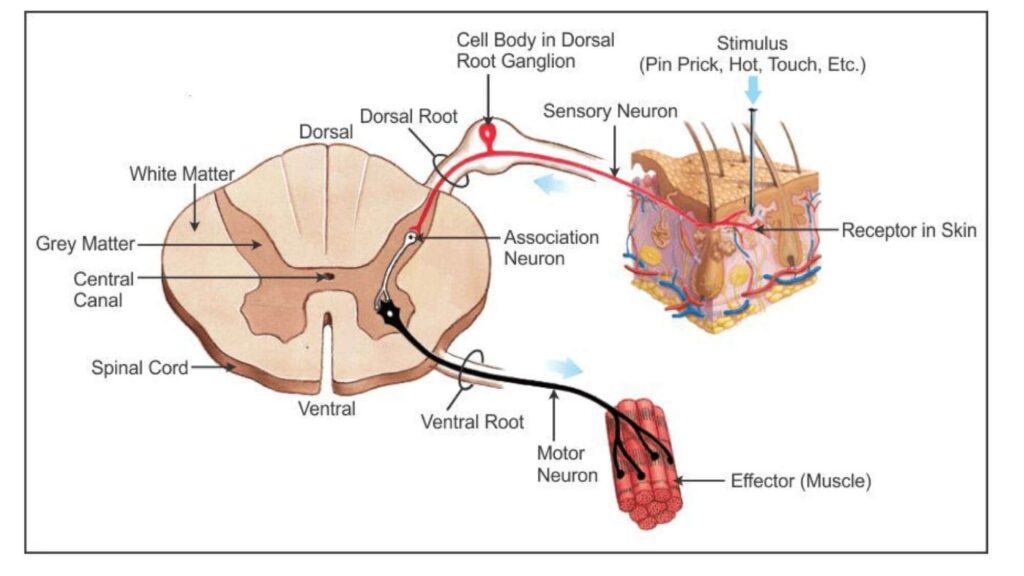
FAQ (Previous year questions)
The forebrain, the largest brain region, governs higher cognitive, sensory, and physiological functions. Its main parts and their functions are:
Cerebrum (Cerebral Cortex: Comprises four lobes): Frontal Lobe: Controls reasoning, planning, voluntary movement, speech (Broca’s area), and emotions.
Parietal Lobe: Processes sensory inputs like touch, temperature, pain; aids spatial orientation and language.
Temporal Lobe: Manages auditory processing, memory (via hippocampus), and language comprehension (Wernicke’s area).
Occipital Lobe: Handles visual processing and interpretation.
Thalamus: Acts as a relay station for sensory (except smell) and motor signals to the cortex.
Regulates sleep, wakefulness, and alertness.
Hypothalamus: Maintains homeostasis by controlling body temperature, hunger, thirst, and circadian rhythms.
Regulates pituitary gland, influencing hormone secretion for growth, metabolism, and reproduction.
Limbic System: Includes amygdala (regulates emotions like fear, aggression) and hippocampus (forms memories).
barcoding in Forensic Science. Mention their limitations.
Forensic science helps solve crimes by giving scientific proof. Techniques like narco-analysis, brain mapping, and DNA barcoding improve investigation accuracy.
These methods help identify criminals and understand how crimes happened.
Each method has its own use but also has some limitations.
Narco-Analysis
Narco-analysis is an investigative technique where a subject is administered a drug (such as sodium pentothal) to induce a semi-conscious state, making them more likely to divulge information that they might withhold in a conscious state.
Importance
Limitations
Facilitates extraction of information from uncooperative suspects.Used in conjunction with other tests like polygraph and brain mapping.Considered a less coercive alternative to physical or harsh interrogation techniques.Provides investigative leads and helps corroborate other pieces of evidence.Assists in reconstructing the sequence of crime events based on suspect responses.Applied in high-profile cases such as the 2002 Gujarat riots and 2008 Mumbai attacks to gather critical inputs.
Not admissible as evidence in court under Article 20(3) of the Indian Constitution (right against self-incrimination).May lead to false or misleading information due to the semi-conscious state of the subject.Raises ethical concerns related to consent, mental health, and human rights.Lacks 100% scientific accuracy; responses can be influenced by fear, imagination, or suggestion.Can be misused by authorities if not strictly regulated and monitored.
Brain Mapping
Brain mapping involves measuring brain activity to detect recognition of information related to a crime, often using techniques like electroencephalography (EEG) to identify specific brainwave responses.
Its objective is to uncover concealed or incriminating knowledge related to a crime.
Importance
Limitations
Helps identify areas of the brain activated during deception, aiding lie detection in investigations.Supports analysis of a suspect’s memory to check for knowledge of crime-related events or objects.Non-invasive and scientific method to supplement traditional interrogation techniques.Assists in narrowing down suspects by detecting “experiential knowledge” of a crime scene.Useful in cases with limited physical evidence, enhancing psychological profiling.
Not universally accepted as reliable evidence in courts due to potential for misinterpretation.Expensive and requires highly specialized equipment and expertise, making it less accessible.Ethical concerns about privacy and the potential for misuse of brain data.May not be effective in detecting deception in all individuals, as it can vary by person.Can be influenced by the subject’s mental state, making results less consistent.
DNA Barcoding
DNA barcoding is a method of species identification using a short, standardized region of DNA, allowing for precise identification of organisms, including in forensic contexts.
Importance
Limitations
Helps in the accurate identification of species, even from small or fragmented samples, enhancing biodiversity studies.Assists in detecting illegal wildlife trade by identifying species in confiscated products.Supports forensic investigations by identifying human or animal DNA found at crime scenes.Enables rapid and cost-effective monitoring of genetic diversity in ecosystems.Facilitates the discovery of new species by providing a simple, standardized method for identification.
Limited to species with existing DNA reference libraries; new or rare species may not be identifiable.May not provide detailed information about species’ ecological role or behavior.DNA degradation in old or poorly preserved samples can affect the accuracy of results.Cannot always distinguish between closely related species, leading to potential misidentification.Ethical concerns regarding privacy when used in human genetic research or forensic cases.
These advanced forensic techniques have significantly contributed to criminal investigations and legal processes.
However, their application must be balanced with ethical considerations, legal standards, and the need for corroborative evidence to ensure justice and accuracy in forensic science.

